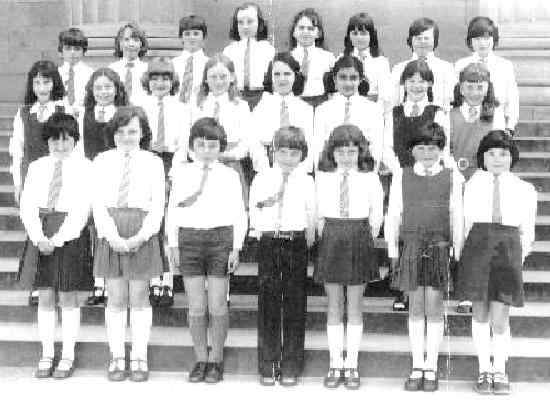
English School Uniform Ties: Wearing the School Tie

Figure 1.--At this English primary school, both boys and girls wore neck ties. Most tucked their ties into their waistbands. Not all did no as at least two boys have ties that can be seen flapping in the wind. Curiously one of those boys has tucked the back tail of his tie in his waistband, but not the front.
|
Schools, with their concern for a smart and uniform appearance, have usually required the tie to be worn 'properly' - that is, with a knot of moderate size drawn up fully and centrally into the shirt collar and with the end of the tie reaching to about the waistband of the trousers. At one time the tie was often tied, especially by younger boys, in a simple form, resulting in a slightly asymmetrical knot, although there was also a more involved form, known in Britain as a 'Windsor knot', defined by the Concise Oxford Dictionary as 'a loose triangular knot 'produced by making extra turns when tying'. I, for example, started tying my Luton Grammar School tie in the latter manner at the age of fifteen or sixteen.
Boys, of course, have sometimes had their own ideas about the wearing of the tie. Younger boys may simply be careless about their personal appearance, having the tie not fully drawn up into the collar or having the knot twisted round the neck so that it is almost beneath one of the ears! With older boys, departure from the rules will usually be more deliberate, influenced by fashion and the peer group. Shirts may be worn with the top button undone and with the knot of the tie pulled down an inch or two - a mode of dress that many English schools (and parents) have regarded - justifiably or otherwise - as a sloppy American trend! In recent decades there has been a fashion for wearing the tie with a large knot and with the end very short - about 3 or 4 inches only. Many schools resist these moves and boys may be told to fasten their ties correctly. Where school ties persist in the future, schoolboys themselves will doubtless continue to wear them - when they can get away with it--in a manner dictated by fashion and by their peer group.
Knots
Schools, with their concern for a smart and uniform appearance, have usually required the tie to be worn 'properly' - that is, with a knot of moderate size drawn up fully and centrally into the shirt collar and with the end of the tie reaching to about the waistband of the trousers. At one time the tie was often tied, especially by younger boys, in a simple form, resulting in a slightly asymmetrical knot, although there was also a more involved form, known in Britain as a 'Windsor knot', defined by the Concise Oxford Dictionary as 'a loose triangular knot 'produced by making extra turns when tying'. I, for example, started tying my Luton Grammar School tie in the latter manner at the age of 15 or 16 years of age.
Loosening the Knot
Boys, of course, have sometimes had their own ideas about the wearing of the tie. Sometimes boys for coimfort loosened the knot. This was not allowed by the school. Younger boys may simply be careless about their personal appearance, having the tie not fully drawn up into the collar or having the knot twisted round the neck so that it is almost beneath one of the ears! With older boys, departure from the rules will usually be more deliberate, influenced by fashion and the peer group. Shirts may be worn with the top button undone and with the knot of the tie pulled down an inch or two - a mode of dress that many English schools (and parents) have regarded - justifiably or otherwise - as a sloppy American trend!
Long Tail
Properly tied the necktie front and back should be about the same length with the front slightly longer to completely cover the tail. In recent decades there has been a fashion for wearing the tie with a large knot and with the end very short - about 3 or 4 inches only. Many schools resist these moves and boys may be told to fasten their ties correctly. Where school ties persist in the future, schoolboys themselves will doubtless continue to wear them - when they can get away with it--in a manner dictated by fashion and by their peer group.
Securing the Tie
We have not noted boys wearing their school ties with either clips or pins. As far as we know these devices were not used. I am not sure why. As a result ties were generally not secured in any way. Sometimes boys' ties can be seen flapping in the breeze. At thes English primary school, both boys and girls wore neck ties. Most tucked their ties into their waistbands. Not all did no as at least two boys have ties that can be seen flapping in the wind. Curiously one of those boys has tucked the back tail of this tie in his waistband, but not the front (figure 1). Some schools disapproved of this, but it was very common at schools.
HBC-SU

Navigate the Boys' Historical Clothing School Uniform Pages
[Main English school tie page]
[Main English School Uniform Garment Page]
[Australia]
[Main England page]
[France]
[Germany]
[Italy]
[Japan]
[New Zealand]
[Scotland]
[Singapore]
[South Africa]
[United States]
Created: May 16, 2004
Last updated: May 16, 2004




